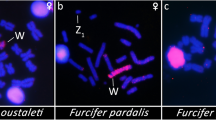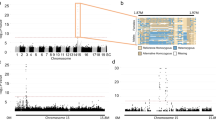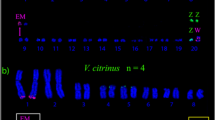Abstract
The gene coding for mannose phosphate isomerase (MPI) has been found to be sex-linked in Common Lizard (Lacerta vivipara) samples from Russia to France. Both sex chromosomes can express one or two codominant alleles. The results are in agreement with the Z1Z2W heteromorphic karyotype described in L. vivipara populations from central France. Allozyme frequencies can strongly vary between regions; in the Austrian population sampled, an allele that is rare or absent elsewhere has been fixed on chromosome W. The possibility is raised that habitat selection involving MPI allozymes will be demonstrated with suitable sampling, while the existence of endocyclic selection has been substantiated. The data suggest that the Z1Z2W sex determination system is older than implied by the literature and possibly fixed in the whole species, but it is concluded that another sex-linked gene than MPI has been instrumental in fixing the translocation involved.
Similar content being viewed by others
Article PDF
References
van Brink, J M. 1959. L'expression morphologique de la digamétie chez les Sauropsidés et les Monotrèmes. Chromosoma, 10, 1–72.
Charlesworth, B. 1978. Model for evolution of Y chromo-somes and dosage compensation. Proc Natl Acad Sei USA, 75, 5618–5622.
Charlesworth, D, and Charlesworth, B. 1980. Sex differences in fitness and selection for centric fusions between sex-chromosomes and autosomes. Genet Res, 35, 205–214.
Chevalier, M, Dufaure, J P, and Lécher, P. 1979. Cytogenetic study of several species of Lacerta (Lacertidae, Reptilia) with particular reference to sex chromosomes. Genetica, 50, 11–18.
Dely, O G, and Böhme, W. 1984. Lacerta vivipara Jacquin 1787-Bergeidechse. In Böhme, W. (ed.) Handbuch der Reptilien und Amphibien Europas, Aula, Wiesbaden, pp.362–393.
Endler, J A. 1973. Gene flow and population differentiation. Science, 50, 243–250.
Endler, J A. 1986.Natural Selection in the Wild. Princeton University Press, Princeton.
Goux, J M, and Pasteur, G. 1986. A sex-linked enzyme in a reptile-association with a recent centric fusion in the common lizard. Genet Res, 48, 21–25.
Heulin, B. 1984. Contribution à V étude de la biologie des popula-tions de Lacerta vivipara. Doctorate thesis, University of Rennes.
Orlova, V F, and Orlov, N F. 1969. Chromosome comple-ments and some questions of systematics of lizards of the genus Lacerta. Zool Zh, 48, 1056–1060.
Pasteur, G. 1977. Endocyclic selection in reptiles. Amer Nat III, 1027–1030.
Pasteur, G, Keymar, P F, and Perret, J L. 1988a.Canarian Skink Systematics: An Introduction. Ecole Pratique des Hautes Etudes, Montpellier.
Pasteur, N, Pasteur, G, Bonhomme, F, Catalan, J, and Britton-Davidian, J. 1988b.Practical Isozyme Genetics. Ellis Horwood/John Wiley, Chichester.
Pilorge, T. 1981. Stratégie adaptative d'une population de montagne de Lacerta vivipara. Oikos, 39, 206–212.
White, M J D. 1957. Some general problems of chromosomal evolution and speciation in animals. In Glass, B. (ed.) Survey of Biological Progress 3, 109–147.
White, M J D. 1973.Animal Cytology and Evolution. Cam-bridge University Press, Cambridge.
Author information
Authors and Affiliations
Rights and permissions
About this article
Cite this article
Salvidio, S., Pasteur, G., Heulin, B. et al. Natural selection and geographical variation in a known sex-linked gene of the Common Lizard in Europe. Implications for chromosomal evolution. Heredity 64, 131–138 (1990). https://doi.org/10.1038/hdy.1990.17
Received:
Issue date:
DOI: https://doi.org/10.1038/hdy.1990.17



